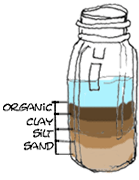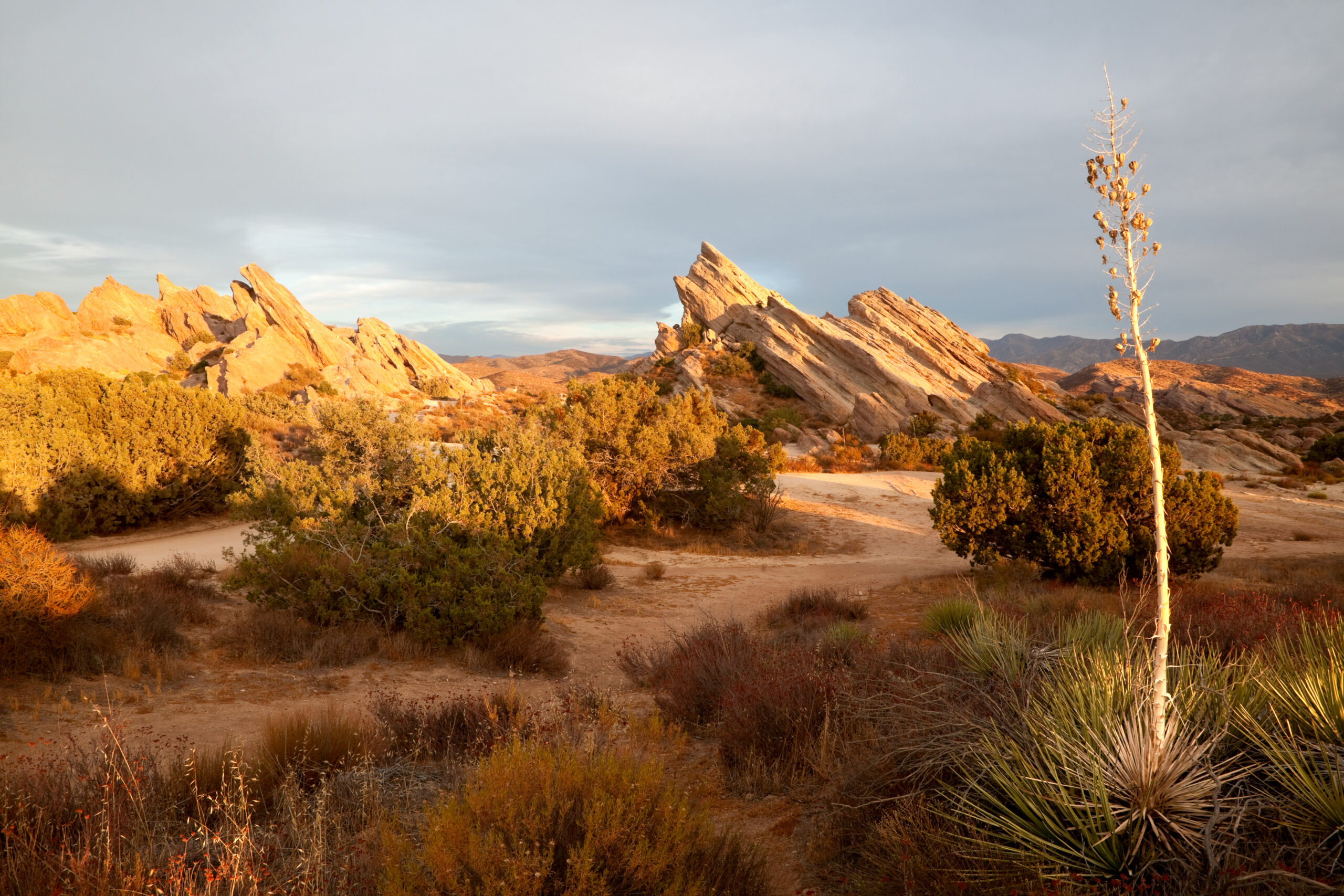Ideal soil has aeration and drainage, yet holds adequate moisture and nutrients for optimum root growth. Your goal is to create an ideal environment for expanding root systems.
An important aspect of Xeriscape gardening includes performing a soil analysis to make sure the soil is adequate to absorb water, hold nutrients. A soil analysis will help you determine what measures, if any, may be required to amend your soil and support your efforts.
Here in the Antelope Valley the general consensus is that everyone’s soil is hard clay. That’s not quite true. Although soil types differ in every area, if your soil seems hard it is most likely that over compaction is to blame.
To be healthy, a soil needs to be able to breath and water needs to move easily through the soil. Compacted soils don’t allow much air to circulate to the root zone and water just tends to run-off. This increases erosion and strips away vegetation and topsoil. A normal, lo-compacted soil helps to absorb and retain water, releasing it slowly allowing the root zone of plants to “breath”. Highly compacted soils typically have less plant growth, which increases runoff.
Each soil type has a unique structure and texture, drainage pattern, PH, and nutrient content and unfortunately there is no exact recipe for soil improvement.
When provided with a good soil environment, Roots of trees and shrubs grow outward approximately seven times the diameter of the root ball during the first growing season. For years we have added organic matter, animal manure, or compost to the planting hole to, conserve moisture, and to improve plant growth. But recent research shows no benefit from amending the planting hole. Even in well-drained soils, organic matter encourages the roots of plants to stay within the hole instead of growing out to explore the native soil.
The best way to plant is to make sure the root ball is level with the soil surface, then simply backfill with the same soil removed from the hole after removing any debris. Tamp the soil lightly to eliminate air pockets. Water thoroughly and add organic mulch, such as pine straw or bark chips, to the soil surface to conserve moisture.
Does Your Soil Drain?
Dig a hole 12″ to 15″ deep to examine the soil horizon. Is it hard and compact or loose and granular? Fill the hole with water and monitor how fast it drains. If water remains in the hole after 12 hours, the soil is poorly drained.
Deep cultivation may be the answer; by breaking up the hard layer of soil several inches below the soil surface may improve drainage. Another option is to bring in top soil or have a professional landscaper incorporate 6″ of coarse aggregate, such as granite sand, into the poorly drained soil.
Analyzing Your Soil: Learning the Characteristics of Different Soil Types
You can send soil samples to a lab or you can perform these simple tests at home and get a very good idea about what type of soil you have. When you gather samples, get them from at least three separate locations in your yard – you can take as many as you want, but three is the minimum, since soil is going to vary at least a bit even on the same plot of land.
Measure by Feel
The first, called the rope test, requires that you squeeze a moist, but not muddy, one inch ball of soil in your hand. Then rub the soil between your fingers.

Measuring for Percentages
Or if you have a little more time and are looking for a more measurable approach, you may wish to try this soil testing method. You will need a couple of clean quart jars (old mayonnaise jars work very well for this test). Click here for instructions.
Sandy soils are found throughout Southern California, but are very common near the mountain foothills, along rivers and streams and certain coastal areas. Sandy soils are typically comprised of approximately 80 – 100% sand, 0 – 10% silt and 0 – 10% clay by volume. Sandy soils are light and very free draining, usually holding water very poorly due to very low organic content.
Loam soils are also common in Southern California, particularly in the valleys and flat areas (flood plains) surrounding rivers and streams. Loam soils are typically comprised of approximately 25 – 50% sand, 30 – 50% silt and 10 – 30% clay by volume. Loam soils are somewhat heavier than sandy soils, but also tend to be fairly free draining, again, due to typically low organic content.
Clay soils are very common in certain areas, particularly around urban areas where fill soils have been used to establish grade in subdivisions and developments. Clay soils are typically comprised of approximately 0 – 45% sand, 0 – 45% silt and 50 – 100% clay by volume. Clay soils are not typically free draining, and water tends to take a long time to infiltrate. When wet, such soils tend to allow virtually all water to run-off. Clay soils tend to be heavy and difficult to work when dry.
Proceed to Step 3: Xeriscape Appropriate Plant Selection

| Cookie | Duration | Description |
|---|---|---|
| cookielawinfo-checkbox-analytics | 11 months | This cookie is set by GDPR Cookie Consent plugin. The cookie is used to store the user consent for the cookies in the category "Analytics". |
| cookielawinfo-checkbox-functional | 11 months | The cookie is set by GDPR cookie consent to record the user consent for the cookies in the category "Functional". |
| cookielawinfo-checkbox-necessary | 11 months | This cookie is set by GDPR Cookie Consent plugin. The cookies is used to store the user consent for the cookies in the category "Necessary". |
| cookielawinfo-checkbox-others | 11 months | This cookie is set by GDPR Cookie Consent plugin. The cookie is used to store the user consent for the cookies in the category "Other. |
| cookielawinfo-checkbox-performance | 11 months | This cookie is set by GDPR Cookie Consent plugin. The cookie is used to store the user consent for the cookies in the category "Performance". |
| viewed_cookie_policy | 11 months | The cookie is set by the GDPR Cookie Consent plugin and is used to store whether or not user has consented to the use of cookies. It does not store any personal data. |
